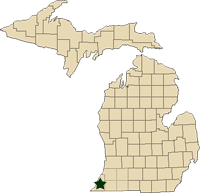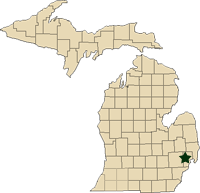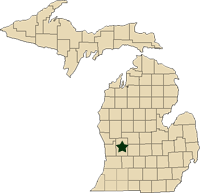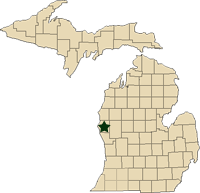Regional reports on Michigan vegetables – July 27, 2011
MSU Extension educators’ pest and vegetable updates for Michigan.
This week’s regional reports:
- Southwest Michigan – Ron Goldy
- East Michigan (Lapeer, Macomb, St. Clair) – Hannah Stevens
- Grand Rapids Area – Bill Steenwyk
- West Central Michigan – Norm Myers
Southwest Michigan – Ron Goldy, Michigan State University Extension
|
Weather
Temperatures were above normal with highs from 81 to 96°F and lows from 59 to 77°F. The area received 0.75 to over 3 inches of rain. Rain came as scattered thunderstorms, so some areas are still dry and irrigation is being applied.
Crop reports
Cucumber, summer squash and zucchini harvest volume has increased as more fields come into production. Squash vine borers are still active, but numbers have decreased from 23 per trap last week to eight per trap this week and damage should be noticeable soon. Virus diseases are beginning to show up in some pumpkin and fall squash plantings. Watermelons are sizing quickly in response to the warm temperatures.
Tomato volume has increased. Bacterial disease symptoms have increased in some fields.
Pepper harvest has begun and eggplant harvest will begin soon. Some pepper fields are showing increased bacterial spot symptoms. Growers feel symptoms increased after strong thunderstorms and wind passed through on July 11.
Sweet corn volume continues to increase as more fields come into production. European corn borer adult activity remains low.
Potatoes are being dug for local, direct market sales.
Green bean harvest continues with no problems to report.
East Michigan (Lapeer, Macomb, St. Clair) – Hannah Stevens, Michigan State University Extension
|
Field conditions
We received a break from the combination of high temperatures and relative humidity over the past two days and the forecast for today (July 27) is for a continuation of this pattern. However, it is extremely dry. More wind is leading to higher potential evapotranspiration rates as well. I would not doubt that some surface water levels are beginning to drop. Irrigation systems are being taxed and irrigators are devoting significant time in maintaining them. Despite this, our vegetable crops look very good as growers roll into harvest.
Crop conditions
Sweet corn is now on the market from the southern to the northern counties (Plasticulture corn has been available for at least a week or two.). With this crop coming in, some farm markets opened early this week and some will be opening this weekend. European corn borer numbers dropped this week in several sets of traps, but this may not reflect activity in the field as egg masses have been found on bell peppers. The disappointing news is that both corn earworm and western bean cutworm moths were caught this week in traps in Macomb. The latter, a new pest, can be a significant problem in sweet corn ears and scouting for egg masses is a good bet. (For more on monitoring, scouting and control recommendations for western bean cutworms, read MSU entomologist Zsofia Szendrei’s article on Western bean cutworms are active in sweet corn.) Redwing blackbirds and starlings have been in the corn for a couple of weeks now and raccoons continue to cause a lot of damage.
Cabbage and snap bean harvest continues, although both may experience some supply fluctuations reflecting wet conditions this spring. Cabbage worm pressure appears to be light in fields I have looked at.
On cucumbers, we continue to be concerned about downy mildew, although other than one case in St. Clair County, it has not turned up. Powdery mildew is in evidence on home gardens on a number of cucurbit crops.
A spider mite outbreak on watermelons has been reported and is not surprising, given the dusty conditions that suppress natural enemies. Reports of squash vine borer insummer squash continue to come in from smaller market gardens.
In tomatoes, the early crop and first set appears heavy while recent hot nights may be blasting some later blossoms. On muck ground, thrips control has been necessary in onions, but very little disease is in evidence. Carrots seem to be healthy as well.
Grand Rapids Area – Bill Steenwyk, Michigan State University Extension
|
West Michigan has been hot, with high temperatures in the mid-80s to low 90s. Nighttime lows ranged mostly from the mid-60s to low 70s. In terms of seasonal heat accumulation, virtually all locales from southern Newaygo County to southern Van Buren County have caught up to the recent five-year average. Rainfall has been variable, with areas from Grand Rapids to the north receiving none to a few tenths of an inch. Many areas south of Grand Rapids received 0.5 to 1 inch.
Celery harvest remains in full force. Yields have been somewhat below average in some areas due to stress from the cold, wet spring. Current harvest yields are improving. Insect and disease pressures are modest overall. Some variegated cutworm, celery leaf tier, aphid and aster leafhopper pressure is present, but has been kept in check. Likewise, early blight, bacterial blight, bacterial soft rot and anthracnose are present, but at modest levels overall. A field scout reports no late blight has been found.
Onions have been developing rapidly. Again, pest pressures are modest. Thrips are certainly present, but not in large numbers.
Sweet corn harvest has just begun. Reports of yield and quality are positive. Pest pressure remains low. My southern Kent County pheromone traps contained no corn earworm moths. The three European corn borer moth traps had counts of 0, 3 and 2.
Cabbage harvest continues with good quantity and quality.
Vine crops look good overall. The pickle and cucumber fields that I have seen look good. Harvest reports have been positive except for a field suffering a severe Phytophthora fruit rot problem. Phytophthora appears to be the most frequently found disease in vine crops at present. Again, however, the overall severity is modest. Zucchini harvest reports are favorable. The hard squash harvest will begin soon.
West Central Michigan – Norm Myers, Michigan State University Extension
|
Temperatures remained above normal this last week. Rains have been spotty and light with amounts ranging from a couple of tenths up to half an inch. Evapotranspiration rates remain high enough that irrigation has continued through the light rains we’ve had.
According to Tom-Cast, purple spot pressure remains high in asparagus. Many full-season harvest fields are at or nearing the trigger for a second fungicide spray. Scouts also report rust active in many fields. Japanese beetle numbers remain high, especially in Jersey varieties, but I still see little sign of feeding by these beetles.
Vine crops are also under disease pressure. I haven’t seen any downy mildew, but powdery mildew is active. Bacterial leaf spots are also active in many winter squash fields. Winter squash and pumpkins are setting fruit now and a rain would be very welcomed in helping that process along. Harvest continues in processing zucchini fields.
In carrots, the leafhopper index in Oceana County keeps going up and then down. I am hoping to get another sample to send to MSU Diagnostics Services today (July 27). Aster yellows disease can be found in carrot fields, but probably less than we normally see at this point in the season. Both major blight diseases are active. According to Tom-Cast, pressure from blights is very high because of the hot temperatures and wetness caused by dew and irrigation.
I caught one European corn borer moth in my traps and no corn earworms again this week. I did catch three western bean cutworms in my sweet corn trap, but had 50 in my field corn trap. Egg mass counts even in the higher field corn site were still below the economic threshold.
Processing broccoli continues to grow. Imported cabbage worms continue to be the major pest in that crop.



 Print
Print Email
Email







